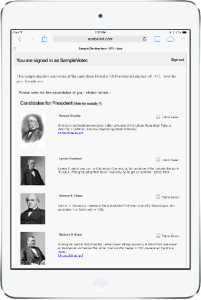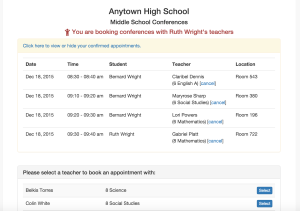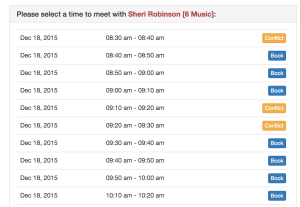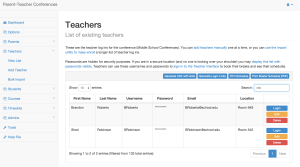A Conversation with Warren Apel, Co-founder of Scholastico
I recently connected with Warren Apel, an internationally-recognized leader in educational technology. After working in international schools for 17 years, he co-founded EdTech startup Scholastico. As an Apple Distinguished Educator and Google Certified Innovator, he has given presentations, workshops and keynotes on educational technology at conferences around the world. We talked about his experience as an educational entrepreneur (edupreneur) and about how improving parent-teacher conference signup has an impact on learning.
Kapp: Warren, explain why you left teaching to create a startup?
Apel: I started teaching in 1998, then moved about ten years ago to being a school technology director. The best part of that job was helping teachers and office staff get better use out of EdTech. In my spare time, I wrote some software to solve some typical school office problems. For a couple of years, I gave those programs away to friends at other schools. In exchange, I got feedback and improvement suggestions. Last year, I decided that these products were good enough to sell. I knew I could build an EdTech startup around them. But I also knew that I wasn’t going to be able to work full-time at a school while also running a business. So I took the big plunge! It has been a wild ride, but completely fun. Scholastico is getting lots of new clients and I’m having the time of my life running a business.
Kapp: Tell me what makes Scholastico different.
Apel: Scholastico as a company is different from most EdTech startups in that all of us have worked at schools. When I was a tech director, I spent a lot of time evaluating software. There are so many apps for schools that are solving a problem schools don’t actually have. Many of these programs are designed by computer programmers who just don’t know how schools operate. So as a company, we’re much more in touch with what schools do and what teachers and principals need. Our mission is to make the job of running a school easier, so that schools can focus on learning.
Kapp: Don’t schools already have software programs that run the school?
Apel: Existing school software is good at doing daily tasks – like taking attendance or recording grades. But there are some gaps; little things that schools struggle with. They tend to be the one-off things that only happened a few times a year. I saw how much time was being wasted by teachers or principals who struggled with these things. I built solutions. I improved the software over time. Now they are slick, easy-to-use programs which solve those specific problems.
Kapp: Which problems, exactly?
Apel: Our first was an election system for student government or school board elections. Then we developed scheduling systems for extracurricular activities and parent-teacher conferences. Right now, we’re working on student-teacher feedback surveys. So that’s four solutions. Each one is a web-based system that schools can subscribe to.

Ecoballot was Scholastico’s first product. Schools use it for everything from homecoming elections and student government to mock elections for government class.
Kapp: Of those four, which are you proudest of?
Apel: Our best-selling program right now is our parent-teacher conference scheduler. On school conference day, at most schools, a parent of a middle school kid will meet with 6 to 10 teachers. Each meeting is short – maybe 5 to 15 minutes long. So the parent ought to be able to have all those meetings in an hour. But each teacher has a different roster of students, creating a huge logistical challenge. The school has to set up a schedule where each teacher meets with the parents of all their students. And it’s an event that they only do two or three times a year, so schools usually don’t try to create a formal system. You often find the secretary doing the entire day’s schedule in Excel or on paper. Or they push it off to teachers. They just tell all the teachers to contact the parents via email or phone and arrange meetings. Parents might have a two-hour wait between five-minute meetings. So you end up with this huge waste of everyone’s time.
Kapp: How is your parent-teacher conference signup different from other systems?
Apel: The biggest difference is the ease of use. We obsessed over every single click to make it as efficient as possible. To organize a conference day, a school will ask a hundred teachers and a thousand parents to perform a task. Every second you can shave off of that process is multiplied as a time savings for the entire school. I designed Scholastico around the school office as a centralized system. I don’t want each teacher to have to set up their own timeslots and conduct their own signups. Instead, the principal or secretary sets up the system for the school in one interface. They send an email to parents which allows them to sign in with one click – no usernames or passwords. And the parents only see the teachers of their children. That is much easier than asking parents to choose from a list of all the teachers at the school. The parents pick the most convenient time that’s available. They can choose mornings or afternoons, depending on their work schedule
They build a conference schedule for their whole family in a few clicks, then they’re done. Every school that has used it has reported that the teachers and parents give them super positive feedback afterwards.
Here is a video of how it works.
Kapp: What were the biggest challenges you faced in launching your business?
Apel: One challenge was the different ways that various schools operate around the world. We have client schools in Europe, Asia, Africa, the Middle East and the US. That means we need to follow different international data privacy laws, which are strict. And schools have different ways of conducting conferences. I’ve tried to build the system to be flexible to allow for different situations. You might have teachers who only work part-time, or parents who also teach at the school. Scholastico can handle all those situations. But the biggest challenge is just understanding that schools are slow to change. They move with caution. I think that’s a challenge for any EdTech startup. A school won’t just jump straight into a new program. They’ll take time, investigate their options, and involve a large team when making decisions. Scholastico isn’t expensive – it’s about 60 cents per student. Still, the sales process often includes a conference call with the school’s admin team. The team sees how the process works and get all their questions answered. Even then, it might take them a few months to make a decision. I have been on school admin teams for years, so I understand how that process works. But it’s entirely different from the fast-paced world of tech startups.
Kapp: So, Scholastico is an EdTech startup, but it’s more about school business processes. It’s not really about improving learning. Is that right?
Apel: Well, yes and no. It’s not something that teachers use directly with their students. There are amazing EdTech companies started by teachers, like Classkick, Pear Deck, or ExitTicket. They’re focused on teaching and learning; they help teachers help kids. We aren’t as direct in trying to improve what happens in the classroom. Instead, we try to conserve time. We know that if we can give some time back to teachers that they’ll have more time to teach. So we improve learning indirectly. But some of the work we’re doing on teacher feedback surveys will also improve teaching. I like Angela Duckworth’s research. She shows that self-reflective metacognition is a crucial factor for success. So when teachers reflect on their students’ feedback, they’re going improve how they teach. Scholastico helps with that. We provide an easy, inexpensive way for each student to give confidential feedback to their teachers. Then the teacher can take that feedback and reflect. They can step outside themselves for a moment. A teacher can use that data from their students to improve their practice. That’s going to improve education, and I’m happy to be part of making that process happen.
Kapp: What advice would you have for instructional design students who are just entering the field?
Apel: First, remember that school is changing, and quickly. If you are a grad student now, there are great opportunities in designing software or e-learning solutions for today’s school environment. However, don’t make the mistake of assuming that school today is the same as you remember it, even if that was just six years ago. Spend the time observing classes and meeting with teachers to learn what the pain points are in today’s classroom. Otherwise, you’ll spend time solving a problem that people don’t really have. The other bit of advice I’d give you is to find the way that your solution adds the most value. There are some excellent ways that customized learning environments can transform education. And there are also some uses of instructional technology that are just high-tech substitutions that don’t really improve anything. Anytime you have the opportunity to design a learning solution or an educational technology system, you should strive to make it as awesome as possible. Create something that allows students to learn in ways that weren’t possible before
Posted in: Education, industry
Leave a Comment (0) ↓



